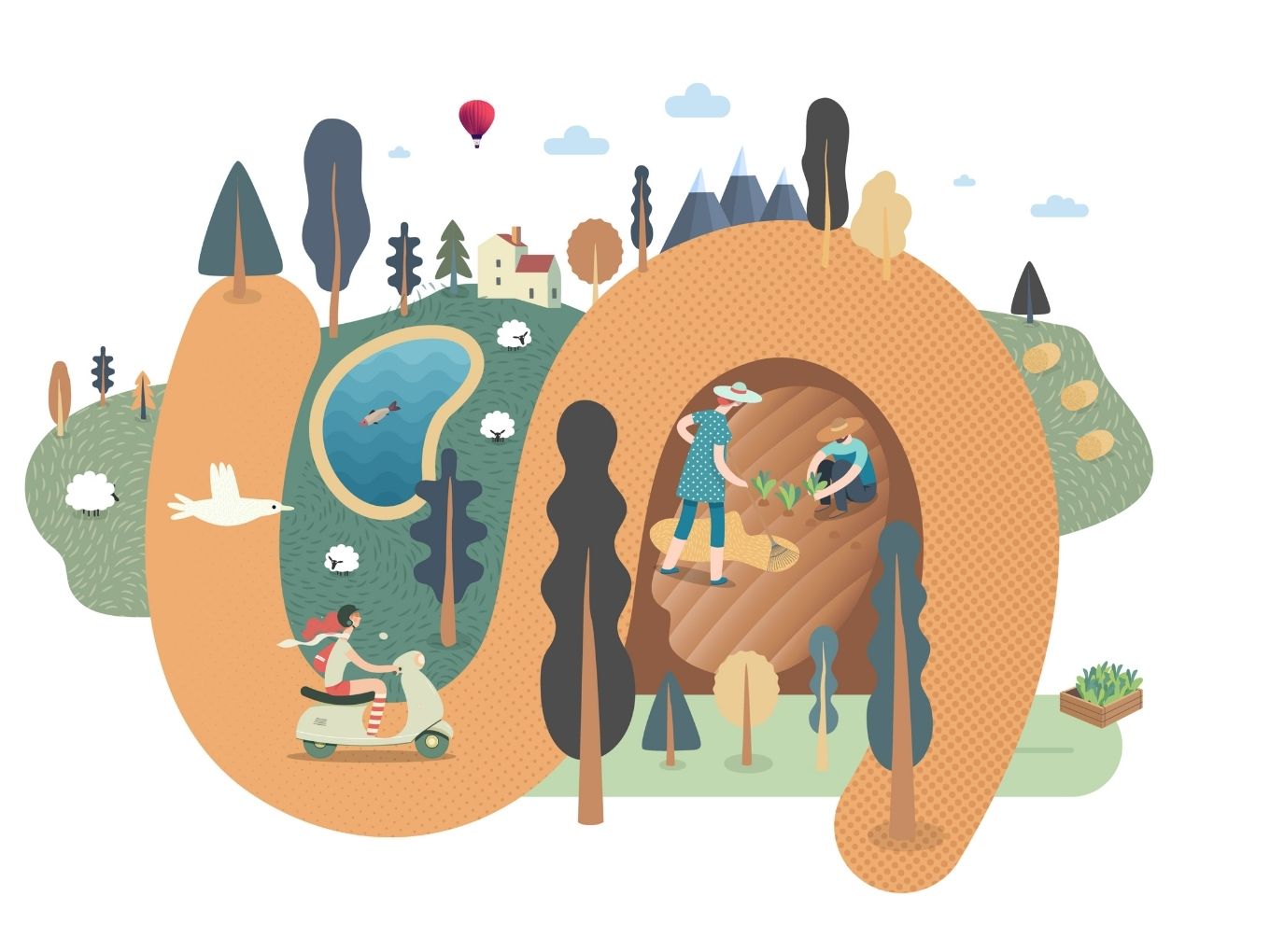
SUMMARY
There are about 80 national parks and 441 sanctuaries in India, which works towards the preservation of wildlife resources in India
Eco-tourism is non-extractive and non-consumptive in nature
From a socio-cultural standpoint, eco-tourism helps in building awareness around political and social issues in developing countries
Ecotourism, also known as sustainable tourism, is a form of sustainable travel that aims to support and uplift the surrounding environment rather than exhausting its resources and putting pressure on it.
India’s topography allows a concoction of terrain and unique flora and fauna associated with it across pan-India ; we have the Himalayan Region, the forest belt in North-east India, Andaman and Nicobar Islands et al. These luscious spots are filled with greenery, resources and local/tribal communities which depend on these for their day to day livelihood. Thenmala based in Kerala is the first-ever planned ecotourism destination built for attracting Eco-tourists and nature lovers.
Currently, there are about 80 national parks and 441 sanctuaries in India, which works towards the preservation of wildlife resources in India. There are also a multitude of Botanical and Zoological Gardens in India, that work towards the enhancement of the Ecosystem in a sustainable way. The India topography ecosystem is an abundant source of flora and fauna, having numerous rare and endangered species spread across the country.
Why The Need?
According to a research by University of Utah,“ Growth in the Travel and Tourism Industry continues to outpace that of the global economy annually, leading by a 4.6% margin in 2018. 2 Travel and tourism are human-resource intensive which creates new jobs and accounts for 10.4% of global GDP. “ The annual growth rate for the tourism industry in India is predicted to be 8.8% between 2011 and 2021 by the World Travel and Tourism Council.
Tourist inflow in any area required additional infrastructure be it water treatment plants, sanitation facilities or lodging space. More often than not local communities are not able to sustainably offer these conditions which puts a lot of pressure on the environment. Vulnerable areas are prone to large scale environmental degradation. Local communities can also be harmed by an influx of tourists as the money influx is rarely directed towards them. Garbage disposal becomes an ordeal to handle.
Goals Of Eco-Tourism
Ecotourism space is gaining momentum in India. It lies in tandem to the vision of sustainability your country is trying to harness, owing to the conservation initiatives it fosters. Eco-tourism is non-extractive and non-consumptive in nature. Steadfastly supported in the Indian ecosystem to preserve wildlife and an animal’s natural habitat, it also helps local indegenious communities to gain some revenue in this symbiotic relationship. According to numerous research, revenue garnered via ecotourism ventures have the potential to improve and streamline long-term economic prospects of India.
From a socio-cultural standpoint, eco-tourism helps in building awareness around political and social issues in developing countries. Both local population and visitors, get more knowledge about the surrounding environmental wealth i.e, it creates an ecological conscience. With this subtle economic incentivisation, the idea of deriving a mutually beneficial relationship with the local communities becomes less of an uphill task.
On-ground research based on conversations with community stakeholders, it has been found that communities are keen to leverage the region’s rich natural capital value through mindful tourism – but lack the investments and infrastructure to do so in a way that is ecologically viable. With over 10.2 million tourists entering the region annually, the potential for driving sustainable growth in the region is immense.
Developing community-owned tourism enterprises would lock-in the value generated through these activities, circulating it through local economies by establishing a strong support ecosystem – organic agroforestry for produce, skilling in the hospitality sector for employment, handicrafts for memorabilia etc.
Mindful natural tourism also has the potential to help conserve threatened species. Income from national parks and other protected areas, for example, have been instrumental in restoring the Hoolock-Gibbon species across the Eastern Himalayas. Investments in mindful natural tourism could provide similar support for endangered Asian Elephant species, particularly in districts with high human-elephant conflict such as Sonitpur and Udalguri in Assam.
Adjusted for inflation, the careful investment could unlock over 2.36 lakhs/hectare in value for ecotourism in the region, providing a much-needed margin for funding conservation activity in the region.
The Opportunity
This brings us to the now, and in the future for some time to come. While the idioms may have changed, the seemingly rising consciousness of the need to be safe, to be healthy, to breathe fresh air and be engulfed in all things natural in the open environs will be the new narrative for leisure and luxury tourism.
Specifically for India, upwardly mobile domestic tourists will now begin discovering their own country – the diversity, the natural bounty, the lesser-known traditions, the lesser experienced cuisines and the potpourri of cultures and communities. In sum, the focus will shift to the environmental, ecological, and socio-cultural aspects of non-urban destinations and getaways and the storytelling will shift from glamorous international attractions to the experiences in the heart of India.
While group travel, MICE, destination weddings will see a decline in the short term, the key to drive custom would be on new experiences driven by the paramount need for personal health and safety. The industry will have to reorient its marketing and sales strategies in line with this requirement – assurances on physical distancing, housekeeping protocols, sanitization of premises and staff, quality of air, and the health benefits that the natural “rural and remote world” provides.
For instance, diverse traditional concepts like Shinrin Yoku or Jungle Bathing in Japan to Doyni Polo in the Himalayas and other forms of traditional practices invoking the blessings of Mother Nature for health, peace and social harmony would possibly emerge as front runners and rework tariffs for self-preservation on the basis of zero-based budgeting.
This paradigm shift will have a much-needed multiplier effect on the bottom of the pyramid rural and semi-urban population, many of whom who have never experienced the benefits of modern industrialization, and whose lives continue to revolve around subsistence living in remote logistically challenged environments – but in the midst of our natural inheritance.
The challenge is maintaining a balance between growing the sector, driving incomes for communities and preventing damage to the environment as well as preventing cultural assimilation pressures.
Bhutan’s success in turning tourism into a key industry, while preserving the integrity of its natural wealth and cultures offers solutions: strict guidelines for tourism to keep it low impact, careful regulation of travel and tour operators, quotas to manage entry and daily tariffs.
Investments must be targeted at developing local capabilities and in strengthening community ownership of enterprises, whether through skilling of communities in the hospitality sector, through the cultivation and development of community-owned homestays and curated biocultural experiences or through sourcing of products from local markets and communities – reducing overall footprint and impact of hospitality.
With passion and by placing community first, by respecting the environment, by promoting a biophilic culture among the team and visitors and by identifying consumer need gaps, even dilapidated bungalows on a tea estate can be turned around to offer among the top 10 nature and experiential destinations. The resilience of tourism depends on its ability to balance people, planet and prosperity: the ecotourism opportunity is the best opportunity to do this.


























